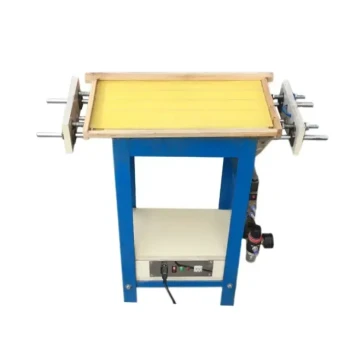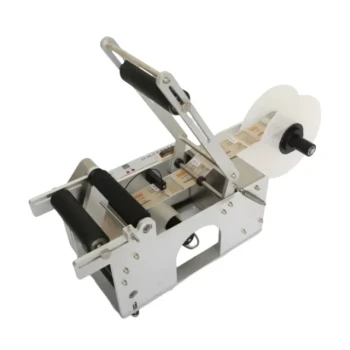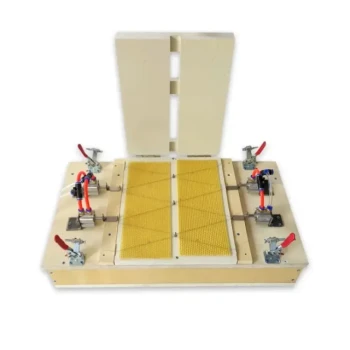At its core, Oxalic Acid Vaporization (OAV) is a method for treating honeybee colonies for parasitic Varroa mites. The process involves heating oxalic acid dihydrate crystals in a specialized device, which turns the solid directly into a fine vapor that fills the hive. This vapor is highly effective at killing Varroa mites that are physically on the adult bees, known as phoretic mites.
Oxalic Acid Vaporization is a powerful tool for reducing mite populations, but its effectiveness is fundamentally tied to timing. It excels at killing mites on adult bees but does not penetrate the wax cappings of brood cells, making a broodless period the critical factor for successful treatment.
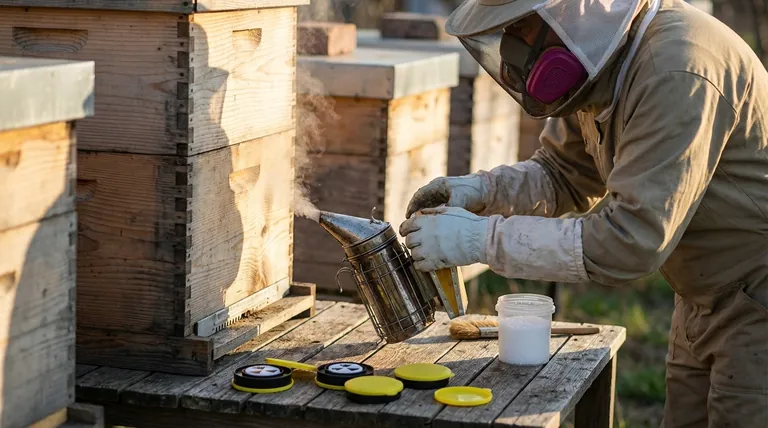
How Oxalic Acid Vaporization Works
Understanding the mechanism of OAV is key to using it effectively as part of an Integrated Pest Management (IPM) strategy for Varroa control.
The Chemical Process
Oxalic acid dihydrate is a crystalline organic acid. When heated to approximately 315°F (157°C) in a vaporizer, it sublimates, changing from a solid directly into a gas. This gas then immediately recrystallizes into microscopic crystals upon contact with cooler air and surfaces inside the hive.
The Mode of Action
These fine oxalic acid crystals coat the bees, hive walls, and frames. When a phoretic Varroa mite comes into contact with these crystals, the acid is absorbed, leading to the mite's death. The primary mode of action is direct contact.
The Critical Limitation: Capped Brood
Varroa mites spend a significant portion of their lifecycle reproducing under the protective wax cappings of developing bee brood. Oxalic acid vapor cannot penetrate these wax cappings. This is the single most important concept to understand. Any mites sealed within brood cells will be completely unaffected by the treatment.
Key Advantages of Vaporization
When used correctly, OAV offers several distinct benefits for the beekeeper.
High Efficacy on Phoretic Mites
For the mites it can reach—those on adult bees—OAV is extremely effective, often achieving a kill rate of over 95%. This makes it an excellent "knock-down" treatment.
Minimal Hive Contamination
Oxalic acid is a natural component of honey and is considered an organic treatment method. When used according to guidelines, it does not build up in the wax or significantly contaminate the honey.
Low Impact on Adult Bees
The treatment is generally well-tolerated by adult bees and the queen, with minimal impact on the colony's health and productivity, provided it is not overused.
Understanding the Trade-offs and Risks
No treatment is without its downsides. Objectivity requires acknowledging the limitations and dangers associated with OAV.
The Broodless Requirement
Because OAV only kills phoretic mites, its success is entirely dependent on the hive's condition. Treating a hive with a large amount of sealed brood will leave the majority of the mite population—the "mite bomb" in the cells—untouched and ready to emerge.
Human Safety Is Non-Negotiable
Heated oxalic acid vapor is a severe respiratory and eye irritant. Using inadequate personal protective equipment (PPE) is dangerous. You must wear, at a minimum:
- A full-face or half-mask respirator with acid gas cartridges (P100 rating). A simple dust mask is useless.
- Goggles to protect your eyes from fumes.
- Acid-resistant gloves.
Potential for Over-Treatment
While gentle, repeated treatments in a short period can cause stress to the colony and may harm open brood. It is a specific tool, not a continuous-use solution.
Making the Right Choice for Your Goal
To apply this knowledge effectively, align your treatment strategy with your specific objective.
- If your primary focus is a rapid mite reduction during a broodless period: Oxalic Acid Vaporization is one of the most effective and efficient tools available for a winter treatment or for newly installed package bees.
- If your hive has a significant amount of capped brood: OAV used as a standalone treatment will be insufficient, as it will not address the mites reproducing within the cells.
- If you need to treat during the summer with brood present: You must use OAV as part of a larger strategy, such as creating an artificial brood break by caging the queen or using multiple, properly spaced treatments to catch mites as they emerge.
Ultimately, successful Varroa management relies on using the right tool at the right time.
Summary Table:
| Aspect | Key Information |
|---|---|
| Primary Use | Treating honeybee colonies for parasitic Varroa mites. |
| Best Timing | During a broodless period (e.g., winter, or with package bees). |
| Key Advantage | High efficacy (>95% kill rate) on phoretic mites with minimal hive contamination. |
| Critical Limitation | Does not penetrate capped brood cells. Mites inside are unaffected. |
| Safety Requirement | Requires a respirator with acid gas cartridges, goggles, and gloves. |
Ready to implement a precise Varroa mite control strategy?
For commercial apiaries and equipment distributors, effective pest management is critical for colony health and productivity. HONESTBEE supplies the professional-grade beekeeping supplies and equipment—including reliable vaporizers and safety gear—you need to execute treatments like Oxalic Acid Vaporization correctly and safely.
Let's discuss your specific needs. Contact our wholesale experts today to find the right tools for your IPM program.
Visual Guide
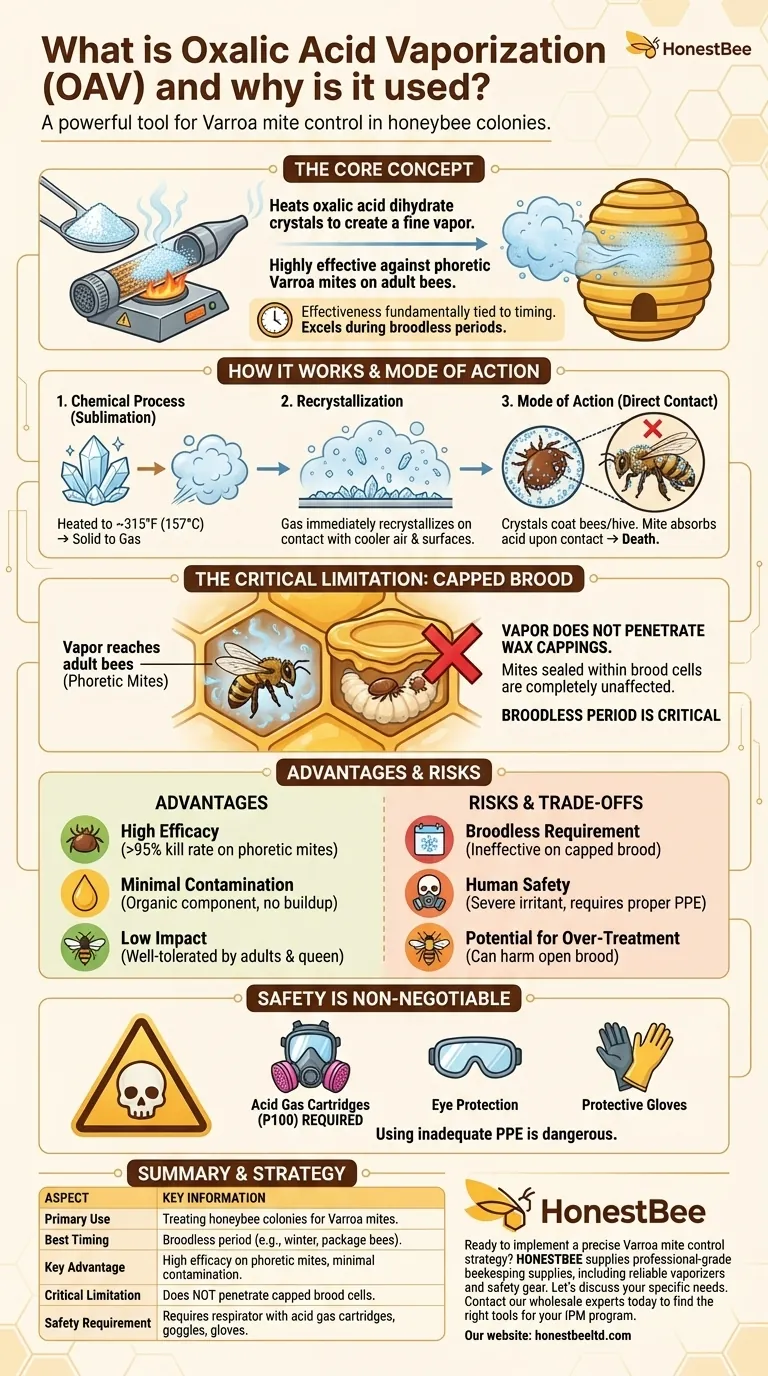
Related Products
- Adjustable Formic and Acetic Acid Dispenser for Bee Mite Treatment
- Professional Galvanized Hive Strap with Secure Locking Buckle for Beekeeping
- Langstroth Screen Bottom Board for Beekeeping Wholesale
- Economy Small Scale Honey Dryer Dehumidifier Thickening Machine
- High Quality Honey Dehumidifier Dryer Thickening Machine for Beekeeping
People Also Ask
- How can beekeepers ensure their hives survive the winter? A Guide to Colony Survival
- What does Chewed Down Brood (CDB) indicate in bee colonies? A Sign of Varroa Mite Infestation
- What is the focus of hive management during summer? Maximize Your Honey Harvest with Expert Tips
- What is the optimal time for varroa mite control in nucs? Maximize Efficacy with Perfect Timing
- What should beekeepers do to manage varroa mites effectively? Adopt a Proactive Monitoring Strategy





